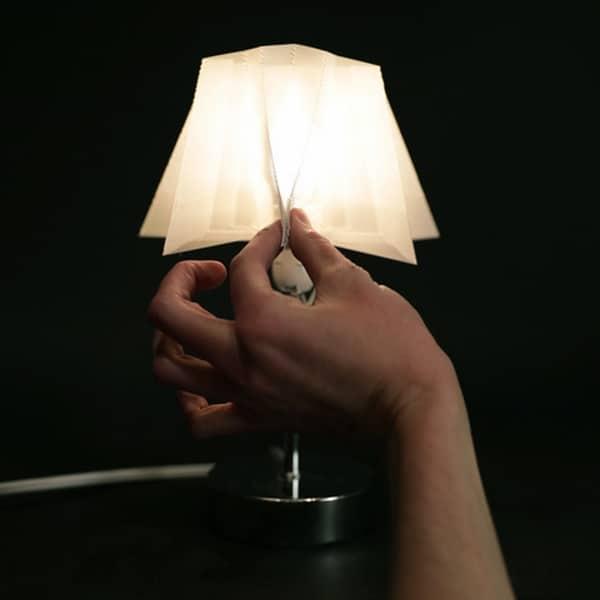DefeXtiles: 3D printing under-extrusion to create a new form of textile
From post-it notes to inkjet printers, many everyday objects are in fact inventions born of coincidences, sometimes even errors made by scientists. Who knows, the latest project from the MIT Media Lab could one day be added to this long list. In a recent article published by the prestigious laboratory, we learn that one of its graduate students, Jack Forman, managed to develop a new type of textile called "DefeXtiles" by exploiting one of the most common errors in 3D printing. : under-extrusion.
The idea would have come to the student by seeing the project of a friend of his from Carnegie Mellon University, which used the under-extrusion of filaments to make vases. This well-known phenomenon of makers, if you don't know it, occurs when a 3D printer extrudes an insufficient amount of plastic. This creates very thin or even missing layers that end up creating prints with randomly positioned holes.
Jack Forman explains that he took advantage of this printing defect by developing a controlled under-extrusion process called “glob-stretch”. A simple $250 desktop FDM 3D printer and standard materials were enough for the young maker to create this new form of jute-like textile. “Unlike previous work, the fact that no custom software or hardware is required – just a relatively inexpensive $250 printer, the most commonly used type of printer – makes this technique accessible to millions of people. Comments Jack Forman.
Jack Forman managed to create a form of textile by taking advantage of under extrusion (photo credits MIT Media Lab)

The glob-stretch process developed by Jack Forman is in fact based on the idea of exploiting these drops linked together by fine threads, which are formed in places during under-extrusion. It is by aligning these drops on a single column that he managed to create a sort of weft as if the piece had been woven.
The student thus conducted more promising experiments using many common 3D printing materials, including a conductive filament used to produce a lamp that can be ignited by touching the folds of the lampshade. The student suggests that other standard or 3D printing materials could produce textiles with magnetic or optical properties, or more biodegradable textiles using algae, coffee grounds or wood.
“Not only are these textiles thinner and faster to print than other approaches, but the complexity of the shapes demonstrated is also improved. With this approach, we can print 3D dimensional shell shapes with a normal 3D printer and without special slicing software,” says Forman. “It's exciting because there are so many opportunities with 3D printed fabric, but it's really hard to get it out there easily because a lot of it uses expensive machinery and special software or special orders that are usually specific to a printer. »
If the various textile 3D printing projects carried out in recent years have unfortunately shown little practical value, this discovery could be a very interesting lead for many textile fields. The student cites several application examples, such as prototyping or customization of clothing, but also in medicine to create 3D printed surgical materials with customizable mechanical properties.
Despite the difficulties in integrating 3D printing into the fashion sector, other than through prototyping or rigid parts, some designers nevertheless manage to do well. To reproduce the characteristics of fabrics, they are indeed a few some like Danit Peleg and the New York studio Nervous System, used algorithms to print parts in chainmail. Panels connected by hinges, which interact in very complex ways, make it possible to obtain garments almost as soft and flexible as fabric. To date, very few companies are working on the development of textile printers. While little information is available on the technology of the company Tamicare, Electroloom the American start-up which had caused a stir, quickly closed its doors.
Lamp with shade printed with DefeXtiles (photo credits MIT Media Lab)
Alexandre MoussionPassionate about 3D printing, I spread the good word to democratize and open this technology to as many people as possible. News, applications, interviews… I work to show individuals and professionals the full potential of this revolutionary tool. Companies, fablabs, distributors, associations, designers, I also want to create through this site an emulation between the different actors in this field. The latest articles by Alexandre Moussion (see all)


![PAU - [ Altern@tives-P@loises ] PAU - [ Altern@tives-P@loises ]](http://website-google-hk.oss-cn-hongkong.aliyuncs.com/drawing/179/2022-3-2/21584.jpeg)

![Good deal: 15% bonus credit on App Store cards of €25 and more [completed] 🆕 | iGeneration Good deal: 15% bonus credit on App Store cards of €25 and more [completed] 🆕 | iGeneration](http://website-google-hk.oss-cn-hongkong.aliyuncs.com/drawing/179/2022-3-2/21870.jpeg)





Related Articles